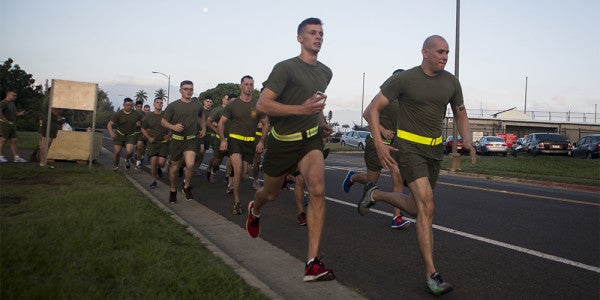Initial PFT Results Are In. Here’s How Marines Between Ages 17 And 39 Are Faring
This year, some significant changes to the Marine Corps Physical Fitness Test went into effect — tougher standards, new exercises,...

This year, some significant changes to the Marine Corps Physical Fitness Test went into effect — tougher standards, new exercises, a revamped sliding grade scale based on age, and more stringent requirements for a top score. As Task & Purpose previously reported, the aim was to make the test more challenging — and the data, as well as feedback from Marines who recently ran the test, indicate that the service may have succeeded.
This year saw a slight decrease in first-class scores, and a significant bump in second and third-class PFTs. But even as top scores dropped, average scores and overall performance on individual events increased.
The preliminary data cited here, obtained by Task & Purpose through a Freedom of Information Act Request, is limited to Marines ages 17 to 39 — while a full age range was supplied to T&P;, the sample sizes for Marines over 40 were too small to be a reliable indicator of emerging trends. The 2017 data is a partial set based on the scores of 46,668 male and 2,990 female Marines between the ages of 17 and 26, plus 12,561 male and 648 female Marines between 27 and 39, who took the annual test between January and April this year.
Here’s what the initial data show:
Marines ages 17–26
For younger Marines, the preliminary data shows similar trend lines for men and women. Female Marines 17–26 earned 15% fewer first class scores than they did in 2016. Second-class scores shot up 60% and third-class scores more than tripled. For male Marines in the same age bracket, the trends went in the same direction, but the numbers were less dramatic: First-class PFTs dropped slightly, second-class scores rose slightly, and third-class earners more than doubled.

Marines ages 27–39
Female Marines between 27–39 saw a significant drop in top scores. First-class scores shrank by 10%, while second-class scores nearly tripled and third-class scores more than quintupled over the previous year. Male Marines saw similar trends: 10% fewer first-class scores, more than double the number of second-class scores, and 10 times as many third-class scores.

Despite seeing a drop in top scores, fewer Marines are failing their physical fitness tests. Failures for Marines between 17–39 have decreased each year for the past five years, indicating that overall fitness in the Fleet Marine Force is on the rise, even if being the best is just a little harder than it used to be.

Overall, average PFT scores have increased in each of the last five years for Marines 27–39, and officials say there’s a reason for that.
“The fact of the matter is, full physical maturation doesn’t happen until the mid to late 20s, in the strength and cardiovascular component,” Brian McGuire, the deputy director for the Marine Corps Force Fitness Division, told Task & Purpose in June.
“We do know Marines are not the strongest in the earlier part of their career, but they get stronger as the years go by,” McGuire said. “Cardiovascular fitness has a more certain decline, but the Marines from 26 to 32, that’s where we’ve seen the highest PFT scores. Not necessarily in the youngest age group.”
Related: Here’s What Marines Have To Say About The New PFT Standards »
Individual event scores are on the rise for Marines in their late 20s and early 30s, as well: For men, pull-ups increased to an average of 20 trips over the bar this year, compared to 17 for the two previous years; run times for both men and women have decreased, and the number of crunches averaged has shot up for both groups. Among female Marines between 27 and 39, they averaged eight pull-ups this year, after seeing a slight decrease in average flexed arm-hang time for the previous years.
This trend — more crunches, more pull-ups, and faster run times — continues with the youngest devil dogs, as well.

Male Marines 17–26 also knocked out more pull-ups this year than in the past five years. Female Marines, who officially switched to pull-ups in January, averaged seven. Men who opted for push-ups averaged 64, while women averaged 41.
In the coming weeks, Task & Purpose will be supplying a more in-depth review of this year’s PFT data and how Marines have adjusted to the new test.
WATCH NEXT:
